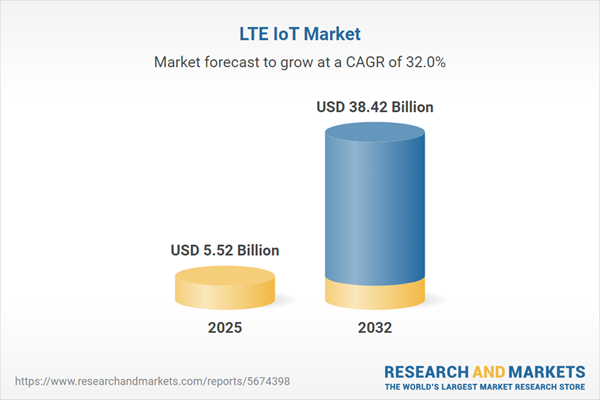Speak directly to the analyst to clarify any post sales queries you may have.
The LTE IoT market empowers senior decision-makers to drive digital transformation by providing secure, scalable connectivity options tailored for complex enterprise needs.
Market Snapshot: LTE IoT Market Growth and Trends
The LTE IoT market is registering accelerated growth, with a notable focus on secure, real-time connectivity across multiple enterprise sectors. This expansion is propelled by enterprise demand for digital infrastructure that delivers resilient data exchange and seamless integration into critical operations. As regulatory environments evolve and industry competition intensifies, organizations increasingly prioritize platforms that enable reliable insight generation and faster decision-making. Early adopters in leading regions underscore heightened commitment to digital advancement, establishing LTE IoT as an essential driver for operational agility and innovation across the enterprise landscape.
Scope & Segmentation of the LTE IoT Market
- Communication Technologies: LTE-M and NB-IoT deliver scalable, cost-efficient connectivity. These technologies are instrumental in asset management and enable broad industrial deployments for diverse use cases.
- Applications: Enterprise applications include asset tracking, connected vehicle ecosystems, fleet optimization, workplace safety initiatives, healthcare data integration, and smart city developments. These uses enhance decision support and reinforce data protection mechanisms.
- End User Industries: Sectors leveraging LTE IoT include utilities, consumer electronics, healthcare, government, logistics, and manufacturing. Each industry adopts the technology to address operational challenges and sustain regulatory compliance.
- Deployment Models: Private LTE networks emphasize advanced data security, public LTE ensures wide accessibility, while hybrid frameworks facilitate integration with existing systems and enable phased digital migration strategies.
- Offering Types: Enterprises utilize a mix of IoT modules, integrated platforms, managed services, and gateways to develop secure, adaptable LTE IoT infrastructures aligned with operational complexity.
- Device Types: Purpose-built hardware including gateways, meters, telematics units, and wearables enables remote oversight and enhances personnel safety across extensive networks.
- Regions Analyzed: Key geographies assessed include the Americas, Europe, Asia-Pacific, and the Middle East and Africa. Regional leaders such as the United States, Germany, China, and Australia play pivotal roles in global market direction and technology strategies.
- Companies Profiled: The report covers leading vendors, among them Quectel Wireless Solutions, SIMCom Wireless Solutions, Fibocom Wireless, Telit Communications, Sierra Wireless, u-blox, Thales, Huawei, Neoway Technology, and Sequans Communications, all recognized for shaping LTE IoT innovation and standards.
Key Takeaways for Senior Decision-Makers
- Implementing LTE-M and NB-IoT enables enterprises to future-proof their digital infrastructure and remain agile as business demands shift.
- Flexible deployment models, especially hybrid approaches, allow seamless upgrades and ensure business continuity during transition phases.
- Prioritizing modular and environmentally responsible device designs supports sustainability and advances supply chain transparency initiatives.
- Collaboration between technology vendors, device manufacturers, and integration partners strengthens compliance frameworks and enhances security for both localized and global operations.
- Anticipating diverse regulatory requirements supports safe, compliant international expansion while optimizing risk management practices.
- Integrated LTE IoT solutions align technology investments with organizational stability, supporting strategic growth and operational resilience.
Tariff Impact: Navigating Supply Chain Pressures
- Recent US tariffs on components have driven enterprises to reevaluate suppliers and reinforce the stability of their supply chains.
- Vendors are responding by enhancing regional partnerships and adapting production strategies to protect delivery timelines during market shifts.
- Adopting broader sourcing and bundled services strategies helps enterprises manage pricing fluctuations and maintain operational consistency under changing market conditions.
Methodology & Data Sources
The report analyzes evidence drawn from established industry resources, authoritative regulatory documents, and recognized technology assessments. Stakeholder feedback from network operators, supply chain partners, and IT management is coupled with subject matter expertise to ensure reliable conclusions.
Why This Report Matters for Decision-Makers
- Provides a comprehensive, evidence-based foundation for strategic planning and technology investment focused on the LTE IoT sector.
- Offers actionable regional guidance to improve compliance, manage risks, and support informed technology adoption across key markets.
- Aligns digital transformation strategies with contemporary sustainability and transparency expectations for enhanced organizational value.
The LTE IoT Market: Strategic Outlook
LTE IoT frameworks equip enterprises with secure, adaptable connectivity to support ongoing transformation. This report offers stakeholders the clarity required to align technology strategies with operational priorities and regulatory developments.
Additional Product Information:
- Purchase of this report includes 1 year online access with quarterly updates.
- This report can be updated on request. Please contact our Customer Experience team using the Ask a Question widget on our website.
Table of Contents
3. Executive Summary
4. Market Overview
7. Cumulative Impact of Artificial Intelligence 2025
Companies Mentioned
The companies profiled in this LTE IoT market report include:- Quectel Wireless Solutions Co., Ltd.
- SIMCom Wireless Solutions Co., Ltd.
- Fibocom Wireless Inc.
- Telit Communications Plc.
- Sierra Wireless, Inc.
- u-blox AG
- Thales S.A.
- Huawei Technologies Co., Ltd.
- Neoway Technology Co., Ltd.
- Sequans Communications S.A.
Table Information
| Report Attribute | Details |
|---|---|
| No. of Pages | 188 |
| Published | October 2025 |
| Forecast Period | 2025 - 2032 |
| Estimated Market Value ( USD | $ 5.52 Billion |
| Forecasted Market Value ( USD | $ 38.42 Billion |
| Compound Annual Growth Rate | 32.0% |
| Regions Covered | Global |
| No. of Companies Mentioned | 11 |









